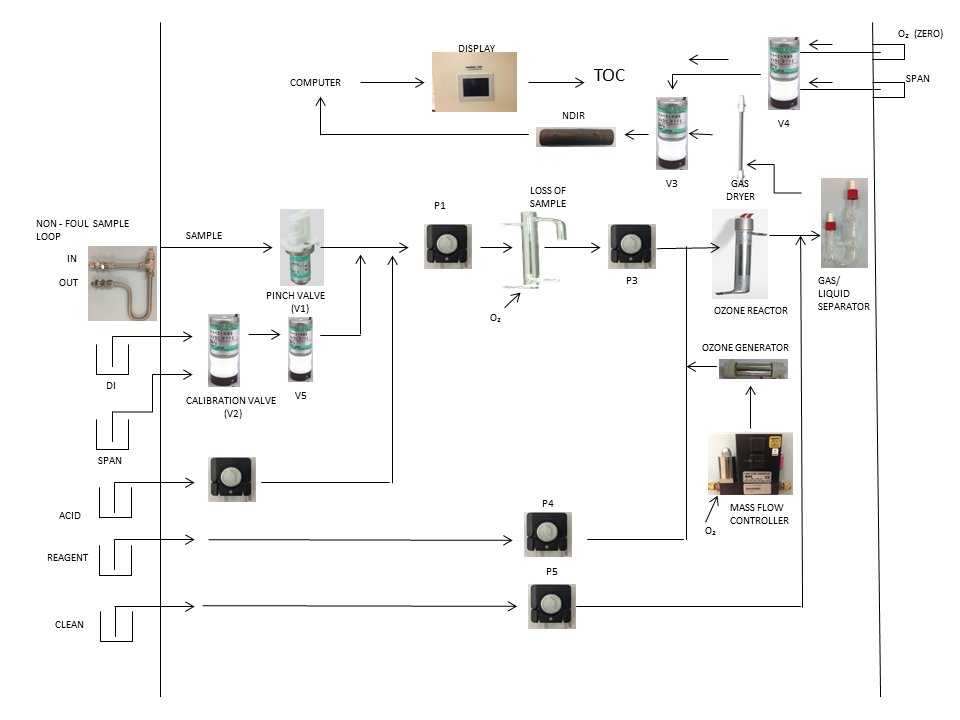Installation

Analyzer Mounting
Model 100 Ozone Hydroxyl Radical TOC
FLOW DIAGRAM OF MODEL 100 OZONE HYDROXYL RADICAL TOC

FLOW DIAGRAM DESCRIPTION
Model 100 Ozone Hydroxyl Radical TOC
OPERATION
Sample is continuously drawn by pump P1 either through a non-fouling sample By-Pass or directly from the bulkhead fitting, if the sample By-Pass is not used. P1 then delivers the sample through pinch valve V1 to the Sparger, where acid is added by pump P2 to lower the sample pH to 2 for conversion of the TIC (Total Inorganic Carbon) interference to dissolved CO2. All sample lines, including V1 have inside diameters of 3.2 millimeters throughout the analyzer in order to prevent blockage by suspended particles in the sample. Comet has avoided traditional TOC methods of placing small orifice valves in the sample lines.
The TIC related dissolved CO2 is continuously sparged out by oxygen in Comet’s counter-flow Sparger which has been shown to be 99% effective in eliminating TIC from the sample, leaving only the Total Organic Carbon of the carbonaceous species. Pump P3 delivers the sample from the Sparger to the Ozone Reactor. Pump P4 delivers sodium hydroxyde or other reagent per application to assure complete oxidation of the TOC to dissolved CO2 in the Reactor. Ozone is created in the Ozone generator at a flow rate of the oxygen feed to the Ozone Generator, which is computer controlled by the Mass Flow Controller for the range selected.
The CO2 and vapor exhaust from the Reactor is directed to the Gas/Liquid Separator where the liquid is separated from the CO2 and other gases and drained while the CO2 gas is dried and proceeds through valve V3 to be analyzed by the Non-Dispersive Infrared Analyzer. The CO2 generated in the Reactor is a direct correlation to the TOC of the sample and is converted as such, displayed and output through various methods as a TOC.
CLEANUP
Pumps P1, P3, and P4 are stopped, blocking downstream flow. Pumps P2 is sped up and delivers an acid wash through the entire sample input system including the interior By-Pass sample tube. P5 is actuated to clean the Reactor. The system automatically returns to its normal operating mode after a programmed or “on demand” actuation by the Operator or in response to an alarm of a sample clog.
CALIBRATION
LIQUID:
Model 100 avoids frequent calibrations due to Comet’s advanced technology and component selections but the analyzer should be checked every six (6) months to verify its calibrated state. Others require a costly periodic maintenance to calibrate and do preventive servicing on the analyzer and have adopted a “trust me “approach that the analyzer will remain in a proper calibrated state, whereas Comet has provided a complete auto-calibration utility to assure maximum “up time” of operation when different processes require recalibration.
To calibrate, V1 is actuated, blocking flow from the sample. V2 is sequenced for automatic DI/Zero and Span calibration solutions in response to computer command.
NDIR GAS CALIBRATION
Comet's advanced NDIR has superior reliability and stability and does not require recalibration for over a year in normal operation. However, again Comet has provided a full auto-calibration utility in recognition that any delay in operation is serious and any problem in the field should be quickly resolved by having all possible remedies available, such as this onboard, easy-to-use automatic NDIR calibration utility.
Periodically a “zero” check is automatically made by flowing oxygen to the NDIR through V4 and V3, performing a completely automatic acceptance or resets the NDIR to a true gas “zero.”
The “end-to-end” NDIR calibration is automatically performed by introducing oxygen and then a CO2 span gas through V4 and V3 as actuated and controlled by the onboard computer.
NORMAL MAINTENANCE AND SERVICE
Refilling of reagent containers and calibration standards are normal maintenance requirements. Because of the historical parts reliability, automatic cleaning and design features, Comet does not require scheduled six (6) month refurbishment or replacement of any part as others do.
COMPONENTS
